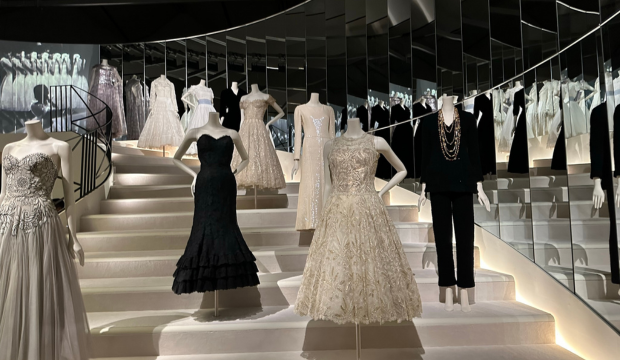
TICKETS FOR GABRIELLE CHANEL. FASHION MANIFESTO ARE AVAILABLE
HERE
The London version of the exhibition, which first ran at Paris's Palais Galliera two years ago, has been re-imagined by the V&A.
It follows Gabrielle Chanel's career and influence in fashion, from opening her first millinery boutique in Paris in 1910 to showing her final collection in 1971.
More than 200 looks and accessories, from jewellery pieces to bags and perfumes, are on display, some coming from the V&A’s collection. New to the exhibition is also a ‘British angle’, demonstrating Britain's critical influence on Chanel from a business and style perspective.
The beginning of the show is simply stunning. Gabrielle Chanel was her own muse: she sought to design fashion garments that catered to the demands of independent women like herself. And one wants to linger for hours before her 1920s creations (sadly displayed behind glass walls), from the ethereal floral printed numbers to the knitted jumper and tweed skirt or the coat with matching chiffon dress.

Chanel’s streamlined silhouettes feel utterly relevant and modern for a woman of today. It is a wonder that 100 years have passed. Clean lines, fluid material, muted colours – black, white, and beige – fine wool, cotton and tweeds, some ensembles resemble Prada’s AW23 collection strikingly. It is practical, elegant and incredibly cool. It is quiet and luxurious yet miles ahead of today’s quiet luxury. It makes you want to live in the 1920s when modernity was still a dream and meet this young woman who created a style to embody the world finally opening itself up to women.
Like any successful entrepreneur, Gabrielle Chanel’s knack for business matched her creative genius. She soon launched her own perfume – N°5 was created with star perfumier Ernest Baux in 1921 – as well as makeup and skincare products, superbly displayed at the centre of the exhibition with their perfect minimalist packages. They were cleverly conceptualised as an extension of her clothing.

She also opened franchises in foreign countries and created ventures in Britain (she adopted the tweed thanks to a partnership with British textiles firms) and the United States, attracting a young, independent clientele from other capitals. The important link between Chanel and the British high and creative society is perceptible in a video of British ‘it girls’ modelling for the brand. One can see how their liberated confidence was a perfect fit for Chanel.

The peerless craftsmanship is also a constant during the exhibition: from evening gowns to quilted bags, embroidery to jewellery (don’t miss the bijoux diamantes section). Behind the design, Chanel’s strength was in the execution and a firm hold on ‘petites mains’, millner, manufacturers and artisans of exceptional savoir-faire.

It's as the exhibition shifts its focus to the Second World War that it loses momentum. Chanel’s Nazi connections during the French occupation cast a shadow on her reputation and business – despite the recent discovery of papers showing that she had a role in the Resistance from 1943. She bowed out of fashion for over a decade, eventually making a comeback in 1954 at the age of seventy-one.
From then, the designer's avant-garde appeal and genius modernity are less noticeable. The final part of the exhibition, resorting to staging evening dresses, loses its innovative appeal and contemporary relevance.

On the way out, Gabrielle Chanel’s everyday black outfit stays with you: humble and practical, it tells of the toiling and unglamorous hard work behind the legacy of one of the most influential women of the twentieth century who changed fashion forever.
| What | Gabrielle Chanel. Fashion Manifesto, V&A review |
| Where | V&A, South Kensington, Cromwell Road, London, SW7 2RL | MAP |
| Nearest tube | South Kensington (underground) |
| When |
16 Sep 23 – 25 Feb 24, 10:00 AM – 6:00 PM |
| Price | £N/A |
| Website | Please click here for more information |
